Difference between revisions of "Helenium bolanderi"
Proc. Amer. Acad. Arts 7: 358. 1868.
FNA>Volume Importer |
FNA>Volume Importer |
||
| Line 32: | Line 32: | ||
-->{{#Taxon: | -->{{#Taxon: | ||
name=Helenium bolanderi | name=Helenium bolanderi | ||
| − | |||
|authority=A. Gray | |authority=A. Gray | ||
|rank=species | |rank=species | ||
| Line 47: | Line 46: | ||
|publication year=1868 | |publication year=1868 | ||
|special status= | |special status= | ||
| − | |source xml=https://jpend@bitbucket.org/aafc-mbb/fna-data-curation.git/src/ | + | |source xml=https://jpend@bitbucket.org/aafc-mbb/fna-data-curation.git/src/eaa6e58056e40c9ef614d8f47aea294977a1a5e9/coarse_grained_fna_xml/V19-20-21/V21_1079.xml |
|tribe=Asteraceae tribe Heliantheae | |tribe=Asteraceae tribe Heliantheae | ||
|subtribe=Asteraceae (tribe Heliantheae) subtribe Gaillardiinae | |subtribe=Asteraceae (tribe Heliantheae) subtribe Gaillardiinae | ||
Revision as of 20:32, 16 December 2019
Perennials, 25–140 cm. Stems usually 1, usually unbranched distally, weakly winged, glabrous proximally, sparsely to moderately hairy distally. Leaves glabrous or sparsely hairy; basal and proximal blades spatulate, entire; mid and distal blades ovate to oblanceolate to oblong-elliptic, entire. Heads 1(–3) per plant, usually borne singly. Peduncles 10–30(–50) cm, usually densely hairy (tomentose near involucres). Involucres depressed hemispheric to globoid, 14–24 × 18–34 mm. Phyllaries (connate proximally) usually tomentose. Ray florets 15–30, pistillate, fertile; corollas yellow, (12–)16–28(–37) × 6–13(–25) mm. Disc florets 300–750(–1000+); corollas yellow proximally, yellow to brown to purple distally, 4–5(–5.2) mm, lobes 5. Cypselae 1.5–2.5 mm, moderately to densely hairy; pappi of 6–8 entire, aristate scales (2.5–)3–4.5 mm. 2n = 32.
Phenology: Flowering Jun–Sep.
Habitat: Bogs, seepage areas, wet meadows
Elevation: 30–200 m
Discussion
Selected References
None.
